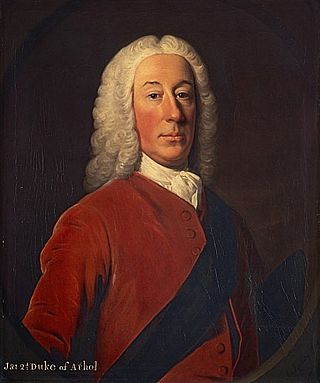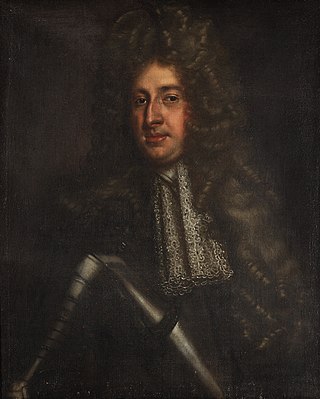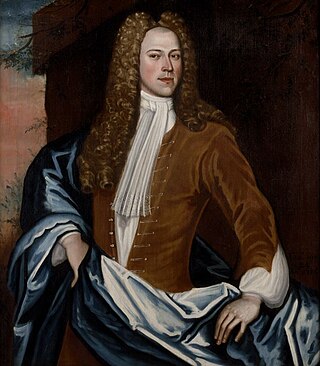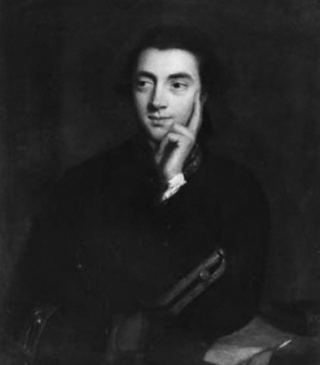Related Research Articles

James Murray, 2nd Duke of Atholl,, styled Marquess of Tullibardine between 1715 and 1746, was a Scottish peer, and Lord Privy Seal.

Kirkby Fleetham is a village in the Hambleton District of North Yorkshire, England about 1 mile (1.6 km) east of the A1(M) road. Along with the two nearby villages of Great Fencote and Little Fencote it forms the civil parish of Kirkby Fleetham and Fencote. At the 2011 census, it was recorded as having a population of 560.

George Keppel, 3rd Earl of Albemarle KG PC, styled Viscount Bury until 1754, was a British general and nobleman. He is best known for his decisive victory over the Spanish during capture of Havana in 1762, as part of the Seven Years' War.

Stephen Fox-Strangways, 1st Earl of Ilchester PC was a British peer and Member of Parliament.
Sir William Frankland, 1st Baronet was an English landowner and politician who sat in the House of Commons from 1671 to 1685.

William Herbert, 2nd Marquess of Powis DL was an English peer and Jacobite supporter.

The Schuyler family was a prominent Dutch family in New York and New Jersey in the 18th and 19th centuries, whose descendants played a critical role in the formation of the United States, in leading government and business in North America and served as leaders in business, military, politics, and society. The other two most influential New York dynasties of the 18th and 19th centuries were the Livingston family and the Clinton family.
George IX (1718–1778), of the Bagrationi dynasty, was king (mepe) of Imereti in 1741. The third son of George VII of Imereti by his wife Tamar, he was enthroned after his brother Alexander V was ousted in the Ottoman-sponsored coup. Later that year, he was rescinded and Alexander regained the crown. George went into exile to his father-in-law George Lipartiani in Mingrelia, but was allowed to return to Imereti during the reign of his nephew, Solomon I.

William Aislabie of Studley Royal, North Yorkshire was an English landowner and Tory politician who sat in the House of Commons for over 60 years from 1721 to 1781. His long unbroken service in the House of Commons was only surpassed, more than 100 years after his death, by the 63 years achieved by Charles Pelham Villiers at Wolverhampton.

Cornelius Smelt was an administrator who served as Lieutenant Governor of the Isle of Man from 1805 until his death in 1832, the longest governorship in the history of the Island. An officer in the British Army, he served first with the 14th Regiment of Foot and then the 35th Regiment of Foot, acting as Deputy Governor of Southsea Castle in the late 18th century. His governorship of the Isle of Man is remembered as one in which he displayed great moral courage in difficult circumstances. His wisdom and fortitude in the long period when the House of Keys and the Duke of Atholl fought their historic political battles were also evident. Upon his death, a memorial was erected in Castletown in the Isle of Man.
Daniel Lascelles, English landowner and politician of Stank and Northallerton, North Riding, Yorkshire, was elected to the House of Commons as Member of Parliament for Northallerton at a by-election on 3 February 1702. He did not stand for election again. He also served as High Sheriff of Yorkshire in 1718–19.

Richard Stevens (1702–1776) of Winscott in the parish of Peters Marland, Devon, was Member of Parliament for Callington in Cornwall (1761–1768).

The Waller family was a Kentish family, of Groombridge Place, that migrated to Hertfordshire and Buckinghamshire in the 14th or 16th century, and then to Gloucestershire, and, for a generation, North Yorkshire.

Cornelius Cayley was a British religious writer and preacher.

Johannes de Peyster or Johannes de Peyster III was the Mayor of Albany, New York three times between 1729 and 1742.
William Lawrence or Laurence was a British politician who sat in the House of Commons on three occasions between 1761 and 1798.

Leonard Smelt was a British Army officer. He also served as sub-governor to Frederick, Duke of York and the future George IV.
The Smelt family was a family from Yorkshire. It owned many of the burgages in Northallerton and was prominent in the town from the mid 17th century onwards.
Leonard Smelt of Kirkby Fleetham, North Riding of Yorkshire, was an English Whig politician who sat in the House of Commons between 1709 and 1740.
Bailey Washington was an American planter and legislator who served one term as a delegate from Stafford County in the Virginia House of Delegates and many years as local justice of the peace.
References
- ↑ "Cornelius Smelt, 1748-1832".
- ↑ "Cornelius Cayley line". 21 August 2017.
- ↑ Vetch, Robert Hamilton. . Dictionary of National Biography . Vol. 52. pp. 401–403.